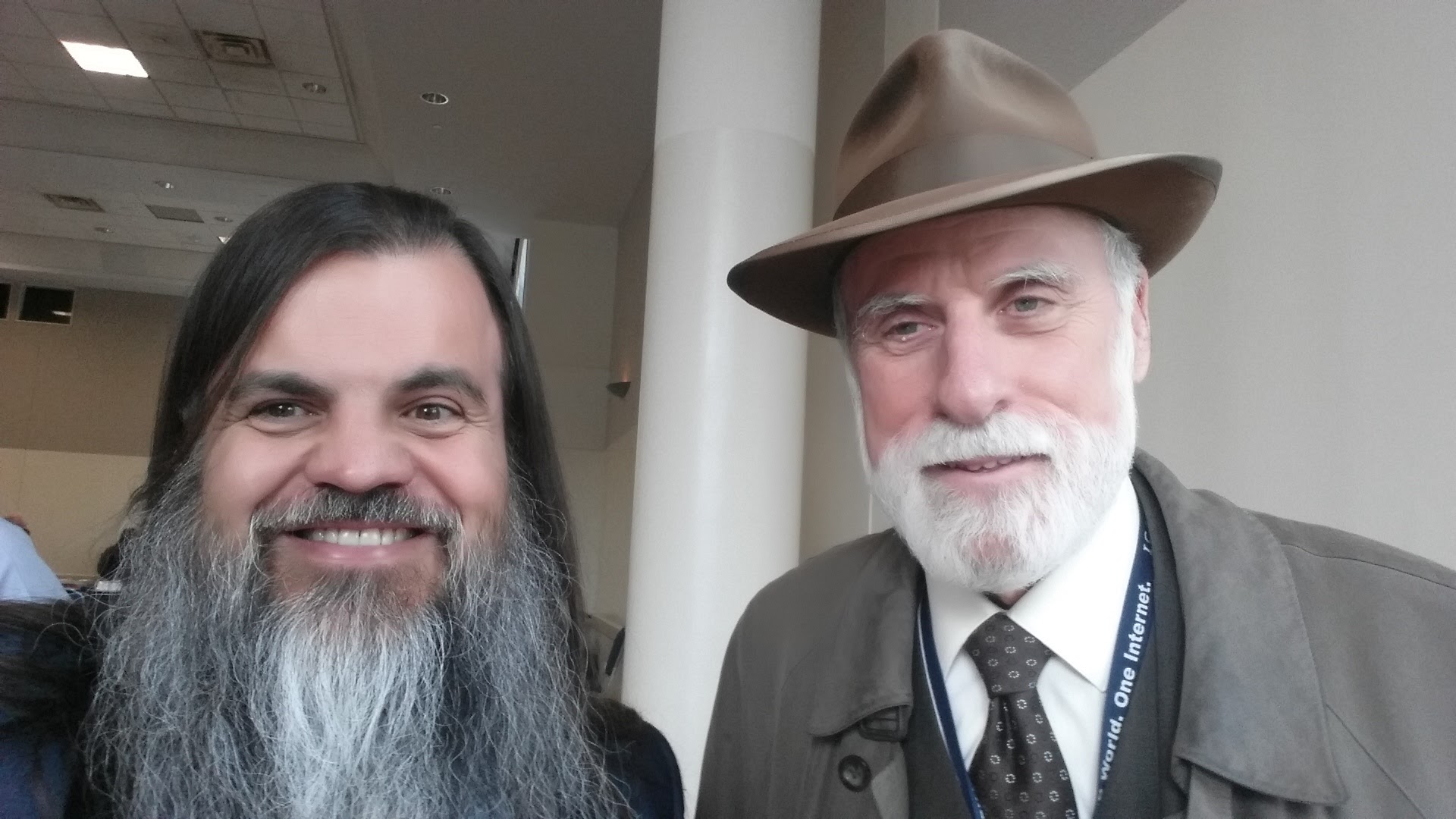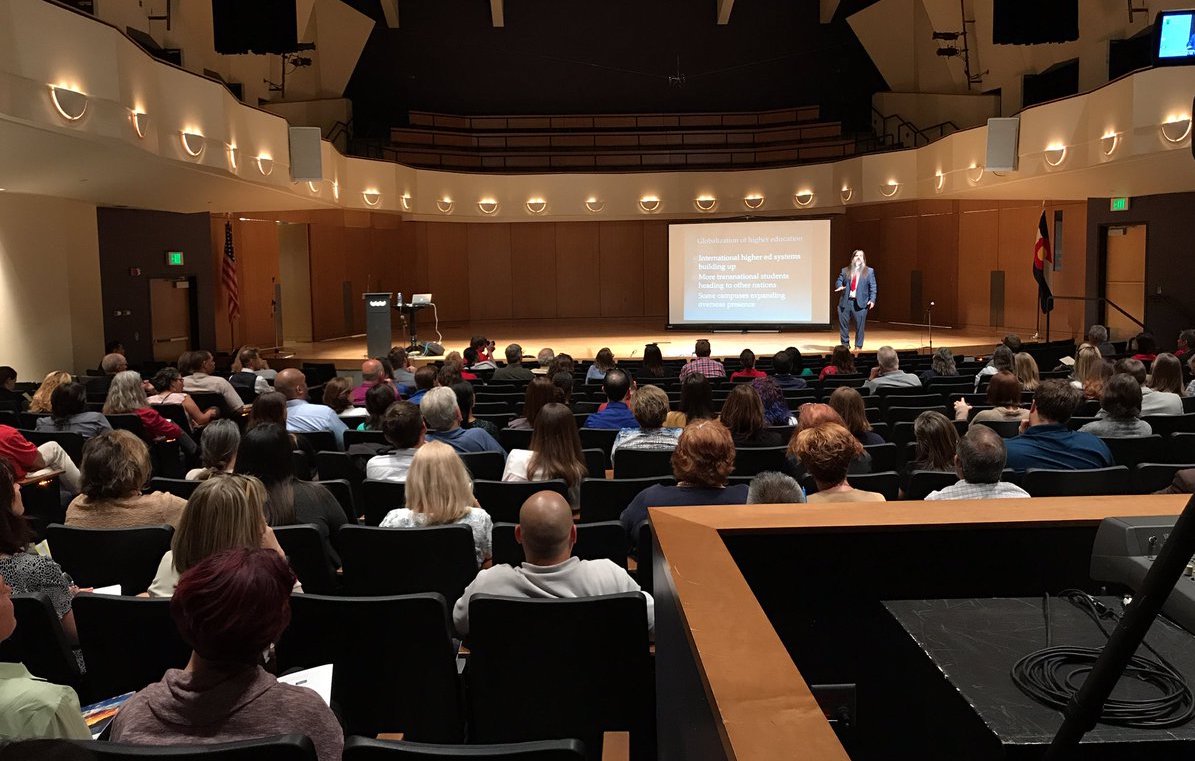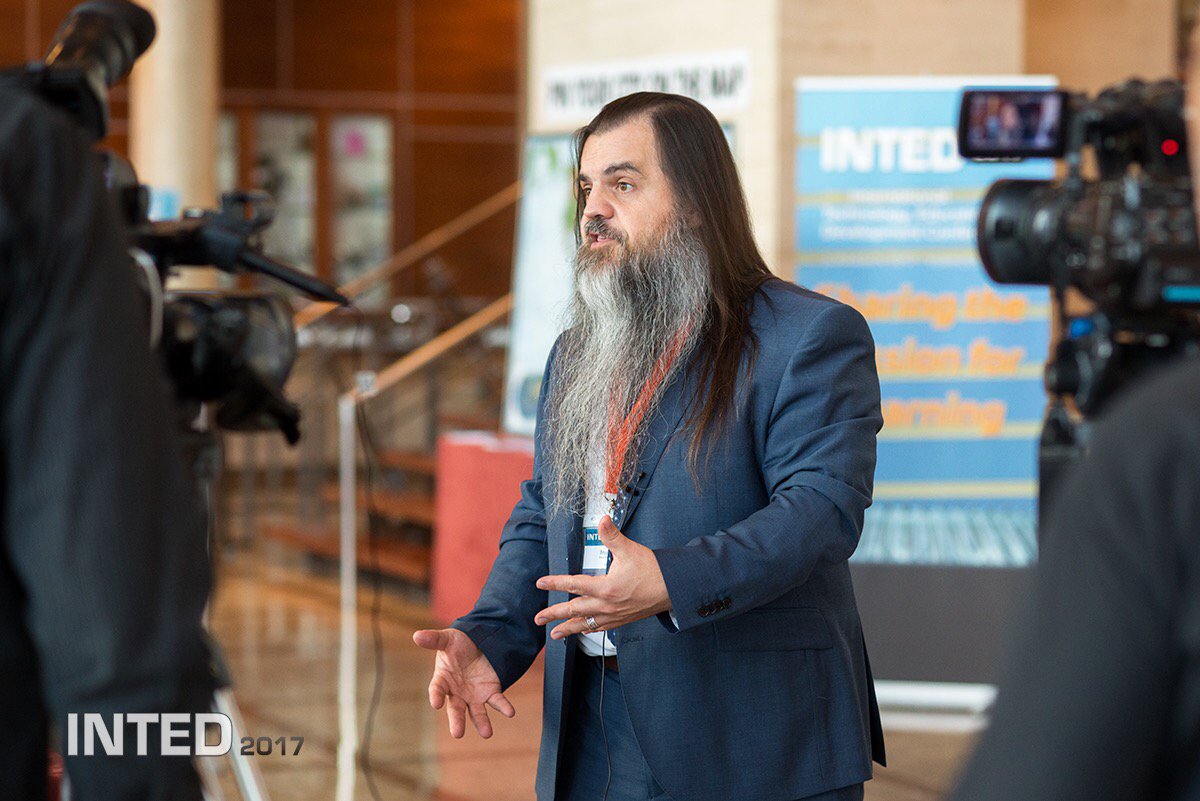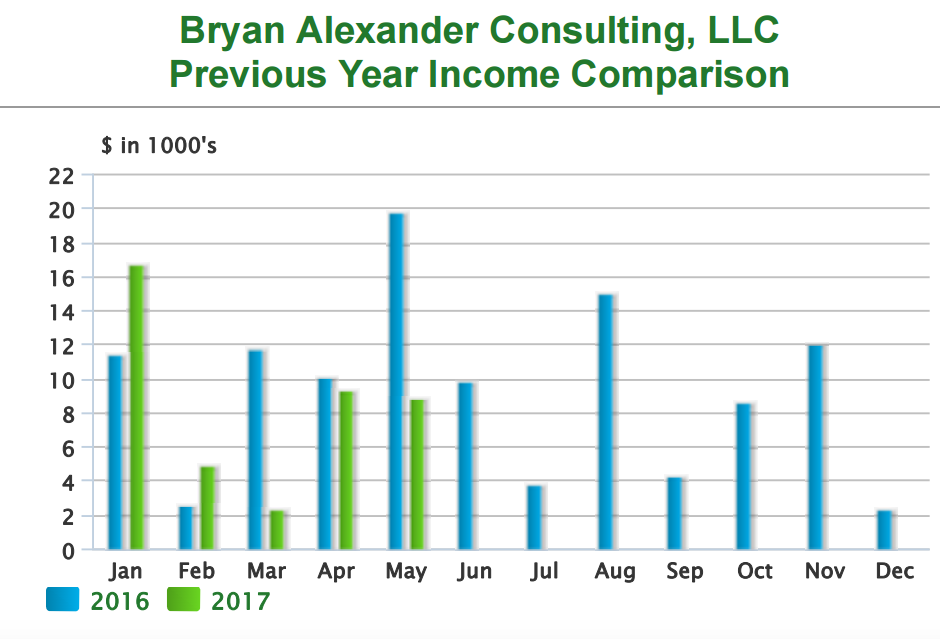Four years ago I launched Bryan Alexander Consulting. BAC is how I translate my future of higher education work into real-world impacts. This post is one of the regular updates I’ve shared, in interests of transparency: so you can learn about the project, and so I can learn from you.
tl;dr – things are good. There are some challenges we need to deal with, and a range of interesting options to consider for the next twelve months.
First I’ll describe the overall picture, then the good things, then challenges, and end with some possibilities for the upcoming year. I’ve added more data in this post than in previous entries, including financials. This is a very rare amount of under-the-hood presentation for a consulting outfit or futurist.

Meeting Vint Cerf.
Overall
BAC is technically a consulting firm (hence the “C”), but acts in many ways like a think tank. I give a lot of talks, both online and virtually, as I have done, and also produce a growing amount of media (books, videos, blog posts, etc).
It’s a very social enterprise. Every step of the way involves conversations with and input from medium to large numbers of people, from crowdsourcing feedback to networking clients to facilitating meetings and webinars.
Good things
The number of international clients and gigs is rising. During the past nine months I’ve worked in Iceland, Finland, Malta, Mexico, and Spain, and with an interesting range of organizations spanning multiple nations.
The number of clients is rising, approaching 100.
Revenue continues to stream in. Speaking engagements are by far the largest income source, followed by consulting assignments (which vary: research reports; workshops; meeting facilitation), then by media creation. The Patreon experiment is off to a good start. Sponsors for FTTE have grown to two.
Facilitation has emerged as a major service, and also something increasingly important to me, ethically and personally. That is separate from our main mission, the future of higher education.
Digital storytelling is another service, which sometimes engages me as a presenter, workshop leader, or content creator (i.e., writing a book).
And digital literacy has surfaced as another competency people want to tap.

Photo by aykendesign.
Speaking of which, I made more stuff in 2016-2017 than before. The New Digital Storytelling, Revised Edition is due out this fall. My next book project proposal is before a fine publisher. FTTE continues to appear, growing to 1770 subscribers. The Forum keeps running in its second year, with more than 1499 people having participated. I blog (250-750 hits/day) and work in other social media (Twitter, Facebook, Google+, podcasts). I’ve been interviewed in various media. Possibly I’ll add more next year (see below).
Challenges
As my readers know, digital infrastructure is a major issue here in Vermont. The state and our ISP’s failures to provide sufficient broadband have driven us to move, a process that’s quite tedious and under way. Connectivity is also an issue when I travel, since airplanes, airports, hotels, trains, cars etc. either lack internet or provision it badly. Hopefully relocation will address the former. The latter worries me, given how ill fares US infrastructure.
 This ties into some problems involved with media production. Obviously having lame “broadband” makes it more difficult to host videoconferences, not to mention downloading and uploading media. Our upload speeds are often ten times what’s available for download.
This ties into some problems involved with media production. Obviously having lame “broadband” makes it more difficult to host videoconferences, not to mention downloading and uploading media. Our upload speeds are often ten times what’s available for download.
Two other problems have cropped up on this score. First, the sheer amount of time required for content production (don’t forget commuting hours, to reach a physical site capable of working in the 21st century); second, the problem of content sprawl. I now make reports, videos, blog posts, the occasional podcast, Twitter chats – it’s all too dis-integrated.
Income stream variability can also be a major challenge. Indeed, at times it looms largest. On the one hand, we have months when payments roar in; on the other, serious dearths. We wrestled with one client for promised payment for three months this year.
Here’s an example of revenue variability, using actual data from 2016 and this year through May (again, being transparent):

So there’s $15,500 coming in one month, then $3,000 in another. $11,000 in January, then barely $2,000 in February. That’s serious variability.
This becomes a growing challenge as our costs increase. Current plans to roll back the Affordable Care Act could boost our medical insurance costs. As Ceredwyn and I age, we are statistically likely to consume more health care. Our children are progressing through higher education (one graduated from university this year!), meaning our debt payments are rising (I’m still paying down mine). Moreover, since I passed 50 years of age, at some point I will be less able to work 70 hour weeks. So we’ll need to stabilize revenue somehow, either by smoothing out the monthly variations or accumulating a thick enough fiscal cushion to painlessly protect us during the trough months.
Possibilities for 2017-2018
Here are some strategic and tactical options we’re considering. They are numbered arbitrarily:
- Hosting a face to face event. This could be a one-day conference, unconference, or workshop. Maybe 2-3 days. The topic: the future of education. I’d love to try out some novel approaches to make an in-person gathering especially worthwhile and meaningful.
- Producing a podcast series on the future of education. It could be reacting to current trends, like a version of FTTE, or an analysis of trends, one per show.
- ” ” video series. Like #2, but with visual components.
- Setting up a new web site to organize all the things.
- Helping build a future of education tabletop game.
- Seeking an institutional affiliation along the lines of a fellowship.
- International growth could stall or reverse, depending on Trump’s actions and the world’s reactions.
- Hiring more people. Some could be on-demand, part time, for specific purposes. Others could help full time with growing demand.
- What should I do with facilitation?
- Increasing fees. Currently I charge $7500 for a keynote speech and $2500/day for consulting, plus expenses. Business logic suggests these should rise. That would yield either fewer engagements but about the same total revenue (good for my health), or the same (or greater) number and higher revenue (good for revenue variability).
- Setting up a retainer system. I would like to establish such an on-call relationship with a client – or formalize what nearly exists informally with some current ones.
What do you make of this update, friends?





Hi Bryan,
Just read your post. Very forthright of you (brave, even) to be so transparent about your business workings. Since we’ve had prior discussion about running a consulting business, I thought I’d share a few reactions with you privately. One of the things that struck me was how different our consulting models are in practice. Granted, some of the reasons they’re different is that we’re in different stages of our careers and are pursuing somewhat different purposes, but I thought of several observations that might be useful for your consideration:
1. Recurring vs. episodic funding. At this point, almost 100% of my income comes from grant-funded projects, so in terms of revenue stream reliability, my situation is nearly the polar opposite of yours. I can pretty much tell you what my revenue stream will be for CY 2018 right now; that’s how far in advance it goes.
I wouldn’t recommend this route exclusively since the kind of work you’re doing requires more flexibility than that, but you might consider whether or not you want to pursue adding a grant-funded client to your mix. It’s always a trade-off between stability and flexibility, but perhaps your particular mix could use a little more flour?
2. Another way to do this is to go the retainer route that you mentioned; I recommend that route if you can find a suitable one or two (again, heeding your need for flexibility). Before my work became so grant-based, my biggest client was on retainer (Sloan-C, actually). Looking back at my records, I see that they constituted ~20–30% of my revenue depending on the year. Again, you may need a different mixture, but retainers also reduce the time required hunting around for new business, and they can also provide opportunities for internal business growth within the organization if it is large enough, which increases synergies and reduces search time.
3. Another thing that struck me is that I get paid a goodly amount for content development as part of the work I do. It took me an embarrassingly long time to realize, this, but I routinely get paid hundreds or thousands of dollars to write reports. (Some times of the year, I feel like I’m back in college with the all friggin’ reports I need to write.) The bad news is that it’s usually not creative content. I’m working on enriching my mix to include more creative content creation, with the tradeoff being that I have much less prospect of getting paid for it. I think the insight here is that I don’t get paid per se for content development; I get paid for developing content as part and parcel of my role (in most cases, as project evaluator). That makes me wonder: what role(s) do you or could you perform for which content development is not necessarily figural but is an integral part of the role?
4. You are wise to be mindful of the amount of hours per week you spend working. My biggest year revenue-wise was about 10 years ago; that was also the year I had significant health problems, partly because of a non-work-related project, but also because I was doing too damn much. The issues went away when I dropped the non-work-related project and stopped working so hard (partly to write my book and partly to enjoy my son’s last year in high school). I am grateful to have had enough financial slack to do that, but any privilege any of us enjoys is grounded in good health. I could not work 70-hour weeks now; in fact, I’m focusing on working far fewer hours than that. Again, that’s the result of my client mix and career point, but the principle is the same: gotta preserve your health.
Those are some observations in response to your post. Happy to have a longer conversation about it some time if you like. In the meantime, thanks again for sharing, and I look forward to working with you on the upcoming Future Trends session soon. (FYI, I will be a client meeting all next week with limited availability; the week leading up to the 22nd is much more open.)
Best, John
>
John, thank you so much for the very generous and thoughtful reply.
1: Working on grant-funded projects is something I’ve explored a bit, but haven’t had any luck with yet.
2: Sounds good.
3: I have had (and currently have) some work writing reports and assessment. I’m not sure how to expand that.
4: Glad to hear it. Not sure how to make it happen.
Definitely looking forward to our conversations!
Bryan,
I am amazed by the amount of things you do. As someone who has been doing similar things on a much smaller scale for more than a decade, I can also very much relate to being on a financial roller coaster. Also at 63 I am now facing age discrimination issues related to getting more work, along with the ominous prospects for affordable health care. I wish I would have socked away money when I was 40 and 50 and working 70 hour weeks back then like you are. Self employment is not an easy road by any means. Stay healthy first, try to save for the future if at all possible, and keep seeking ways to earn more while possibly working less. Best wishes.
Thank you, my friend. Very kind of you to say.
We’re in this together.
Retainers are *great*. When I made my living consulting, retainer clients provided maybe 1/3 of my income. The deal was, they payed a flat rate for a certain number of hours each month (contracted quarterly) whether they needed all those hours or not. In return, they got about a 35% discount per hour. They never hesitated to use my services, were never surprised by a bill, and I knew I had a large chunk of my paycheck in the bank each month. Made everybody happy.
Do you give yourself a “paycheck” each month? This was huge for my piece of mind. On the first of the month, I’d transfer my pay into the household account. What remained in the business account was for biz expenses (taxes got put into savings when I deposited client checks). I could easily calculate “I have X months of pay on hand,” which Smooths out the income spikes/valleys and just eased my mind a lot. Of course, you have to get to the point where you have more than one month’s income in the bank at a time, but if you have $15,000 months, you probably do.
Emily, thank you for these thoughtful comments.
I’m glad to hear retainers worked well for you.
We do a paycheck, pretty much. But the spike/valley pattern sometimes blocks that.
Thank you so much for your research & information.
Consulting is like walking a tightrope, it is exhilarating &
terrifying at the same time. Working in the creative world
it is always interesting to see the back end of business &
how various techniques & models work for some & are
completely useless in others. Now with the proliferation
of online presence, things get really interesting, there is
a huge digital shift in 2017 & beyond that will really be a
game changer for us smaller entities, all the best in terms
of growth & sustainability! Your Idea for a tabletop game
really has us fascinated!
Pingback: 1 – Four years in: under the hood of my consulting firm
I second the emotion above this post from 924 Collective and the other posts too :).
I really think the idea of a retainer system.. “Setting up a retainer system. I would like to establish such an on-call relationship with a client – or formalize what nearly exists informally with some current ones.” is really a good way to proceed #11- Maybe consider something like a certificate type of credential to add value for the retainer system..http://msrops.blogs.com/akac/files/Certificate_Development.pdf.
I am not sure how many mini- certificate types are available right now in future ed content area – but maybe worth taking a look at or offer a new one? I have paid 35.00 and more for Coursera and Canvas, Future Learn type certificates. Maybe think about mini courses 4-6 weeks experience certificates— I call these experiences and not sessions or courses to be innovative ad have your Future Trends incorporated into these experiences.
Also, maybe interview for an intern to help with social media/ facilitation.
Sending you more Awesomeness and Best Wishes,
Roxann
Pingback: Four years in: under the hood of my consulting firm — Bryan Alexander | Cochran Consulting